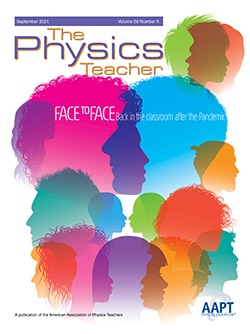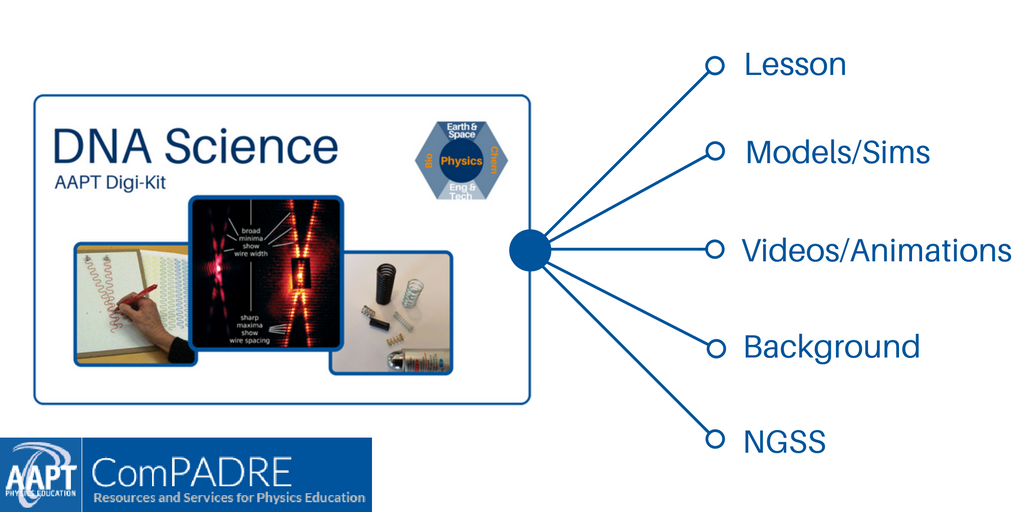
The Physics Teacher September 2021
Volume 59 Issue 6
This Month's Cover...colorfully depicts a variety of silhouettes representing the spectrum of students we expect to engage face-to-face in physics class this school term, some of us for the first time since spring 2020. (Cover art by Jen Geanakos.)
Authors should submit their article and cover letter at this website: http://tpt.peerx-press.org/.
Columns
And the Survey Says..., Astronotes, Figuring Physics, Just Physics, iPhysicsLabs, Little Gems, Physics Challenge for Teachers and Students, Fermi Questions, Talkin' Physics, Technology In The Classroom, Tricks of the Trade, Visual Physics, and Websights.
LETTERS TO THE EDITOR
Rotorcraft RPM on Mars by Philip Blanco. DOI: 10.1119/10.0006112
Please, look again by Terry Toepker. DOI: 10.1119/5.0045206
Greenslade response by Thomas B. Greenslade. DOI: 10.1119/5.0054817
Comment on “Solving More Calculus-Based Physics Problems with Trigonometry” by Leonid Minkin. DOI: 10.1119/5.0056768
EDITORIAL
Greetings! by Gary White. DOI: 10.1119/10.0006114
AAPT AWARDS
AAPT Awards. DOI: 10.1119/10.0006115
Papers
Maintaining Essential Course Features When Moving Introductory Physics Labs Online by Kathleen Koenig and Sarah Bake. DOI: 10.1119/5.0039606
Using Math in Physics: 1. Dimensional Analysis by Edward F. Redish. DOI: 10.1119/5.0021244
Evidence-Based Principles for Worksheet Design by Eric Burkholder, Nicel Mohamed-Hinds and Carl Wieman. DOI: 10.1119/5.0020091
Meeting Laboratory Course Learning Goals Remotely via Custom Home Experiment Kits by Daniel Howard and Mariel Meier. DOI: 10.1119/5.0021600
Bringing Physical Physics Classroom Online – Challenges of Online Teaching in the New Normal by Da Yang Tan and Jer-Ming Chen. DOI: 10.1119/5.0028641
Teaching University Physics Courses During the Coronavirus Pandemic (COVID-19) by Petar Mali. DOI: 10.1119/5.0032461
Eye Accommodation, Near Vision, and Far Vision from a Geometrical Optics Point of View by Zahra Asadollahi and Vola M. Andrianarijaona. DOI: 10.1119/10.0006116
Young’s Two-Slit Experiment Without a Laser by J. P. Sharpe and C. Yee. DOI: 10.1119/10.0006117
A Simple Way to Demonstrate and Explain Different Facets of Mirages by Yuan Zheng, Zewei Huang and Yanbin Yang. DOI: 10.1119/10.0006118
An Inexpensive Apparatus to Study Conservation of Angular Momentum in the Introductory Laboratory by J. P. Polley. DOI: 10.1119/10.0006119
Discovering Newton’s Second Law of Motion in the Classroom by Robert Andreas Austin. DOI: 10.1119/10.0006120
Will the Wheel Stand Still Uphill? by Roberto De Luca. DOI: 10.1119/10.0006121
Inexpensive Physical Pendulum with Arduino by Milentije Lukovic, Vanja Lukovic, Milos Bozic and Vojislav Vujicic. DOI: 10.1119/10.0006155
Reflections on a Competency-Based Physics Course by P.-M. Binder and Hannah L. Blue. DOI: 10.1119/10.0006122
How Eccentric Is the Orbit of the Earth, and Where Is the Sun? by Barbara Rovšek. DOI: 10.1119/10.0006123
A New Lecture-Tutorial for Teaching Interferometry to Astro 101 Students by Colin S. Wallace, Chase Hatcher, Timothy G. Chambers, Seth D. Hornstein, Julia Kamenetzky and Edward E. Prather. DOI: 10.1119/10.0006124
Designing a New Leaning Tower Demonstration by Thomas B. Greenslade. DOI: 10.1119/10.0006125
Low-Cost Astrophotography with a Smartphone: STEAM in Action by Marcos Emanuel Paula and Daniel Neves Micha. DOI: 10.1119/5.0019345
The Ball Bearing High Voltage Generator – A Demonstration Apparatus Illustrating Electrostatic Concepts at Multiple Levels by Hans Pfister. DOI: 10.1119/10.0006126
The On-Axis Magnetic Field for a Single, Helical Turn Coil by Richard Taylor. DOI: 10.1119/10.0006127
Using the Thomson Jumping Ring to Study the Effect of Eddy Currents and Skin Depth on Ring Jump Height by Patrick McCaughin and Lyle Ford. DOI: 10.1119/10.0006128
Nodes and Antinodes in Two-Color Chladni Figures by Adolf Cortel. DOI: 10.1119/10.0006129
Wien’s Displacement Law and Blackbody Radiation Quartiles by I. González de Arrieta. DOI: 10.1119/10.0006130
Graphic Relation Between Amplitude and Sound Intensity Level by Jorge Pinochet, Walter Bussenius Cortada and Mauricio Sánchez Peña. DOI: 10.1119/10.0006131
Demonstrating Conical Pendulum Stable and Unstable States by Leonid Minkin and Daniel Sikes. DOI: 10.1119/10.0006133
Use of a Simple Homemade Apparatus to Teach Basic Thermal Concepts – Six Qualitative Demonstrations/Experiments by Georgios Stylos and Konstantinos T. Kotsis. DOI: 10.1119/10.0006134
A Simple Estimation of the Size of Carbon Atoms Using a Pencil Lead by Ricardo Medel-Esquivel, Isidro Gómez-Vargas, Ricardo García-Salcedo and J. Alberto Vázquez. DOI: 10.1119/10.0006135
Methods to Select the Scales and Starting Values for Axes in Linear Graphs by Joel Hernandez and Barys Korzun. DOI: 10.1119/10.0006136
Systematic Errors and the Chappaquiddick Accident by Rod Cross. DOI: 10.1119/10.0006137
A Scaffolded Approach to Laboratory Report Writing for Non-Major and Introductory Physics Classes by Kimberly Riegel. DOI: 10.1119/10.0006138
The Tacoma Narrows Bridge Collapse Revisited by Kevin Kilty. DOI: 10.1119/5.0026060
Studying the Rate of Evaporation Using Pocket and Computer-Supported Weighing Scales by Petr Kácovský. DOI: 10.1119/10.0006140
Fostering Students’ Values Through Role Play about Socioscientific Issues by Bahadir Namdar and Aysegul Oguz Namdar. DOI: 10.1119/5.0019320
Race and Physics Teaching Collection Resource
Race and Physics Teaching Continued May 2020-January 2021
DNA Science Lesson & Digi-Kit
Inspired by an article from The Physics Teacher, this multidisciplinary lesson and digital resource collection is based on How Rosalind Franklin Discovered the Helical Structure of DNA: Experiments in Diffraction (Braun, Tierney, & Schmitzer, 2011). Click the image to access this resource.


